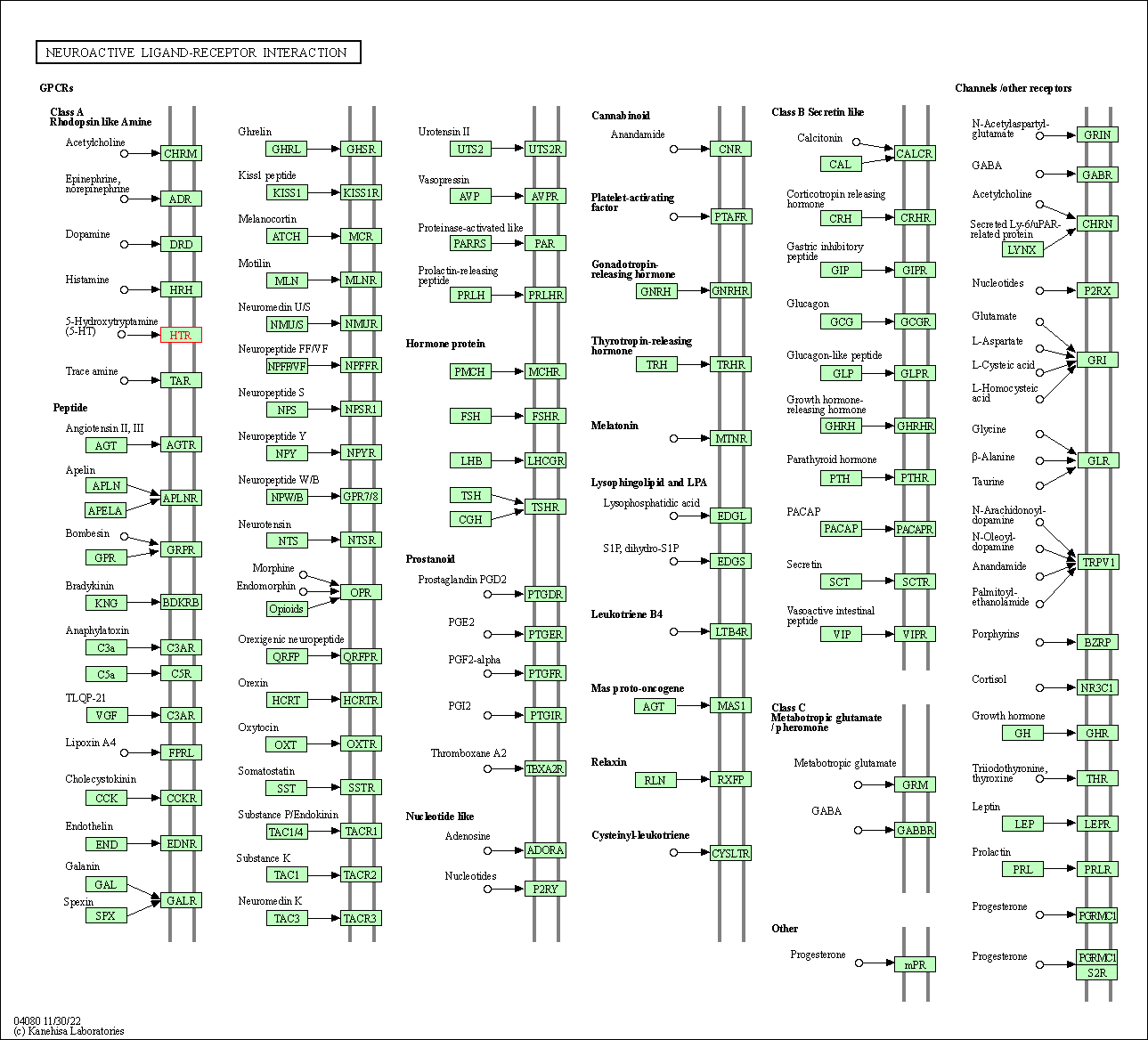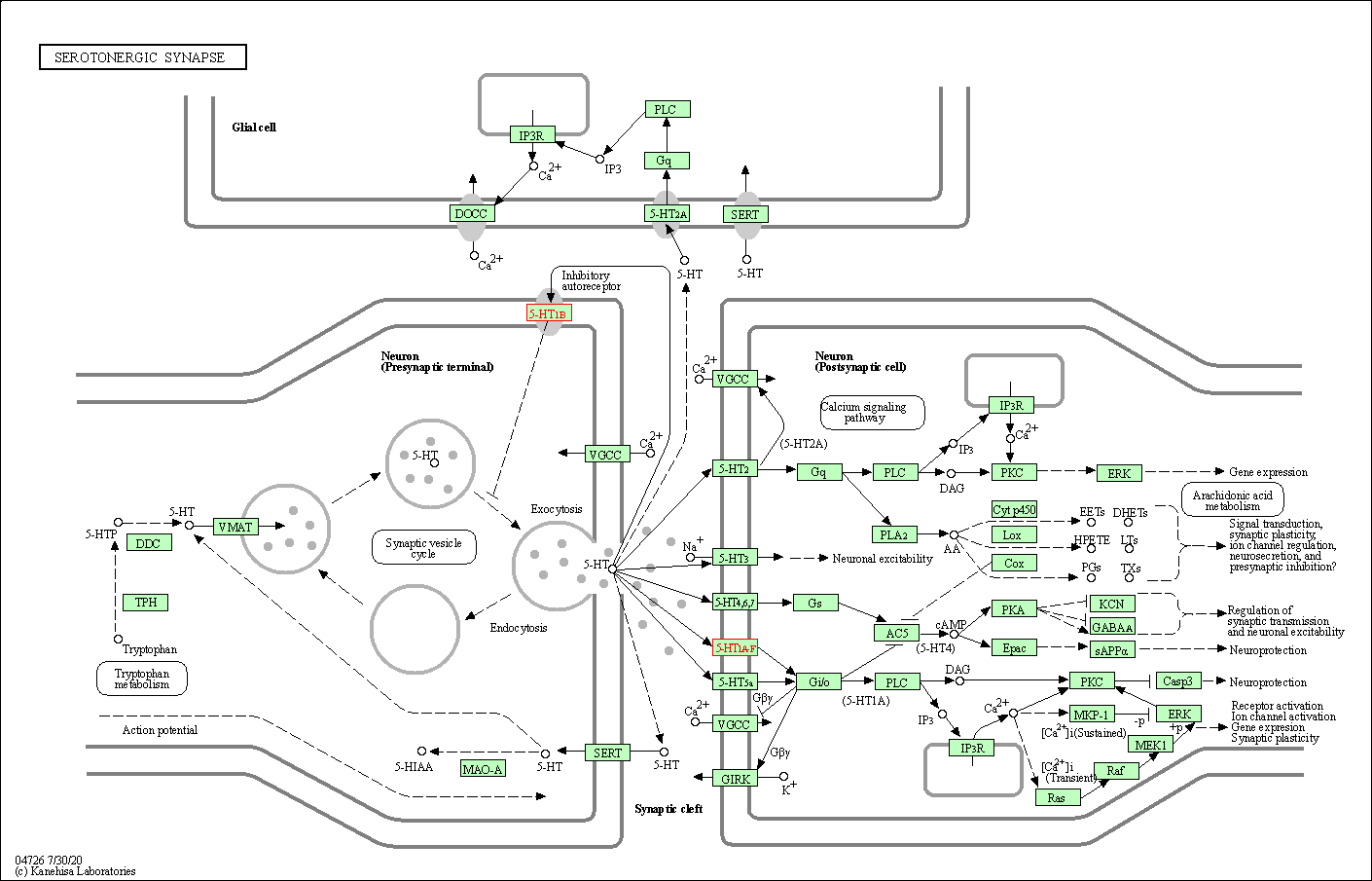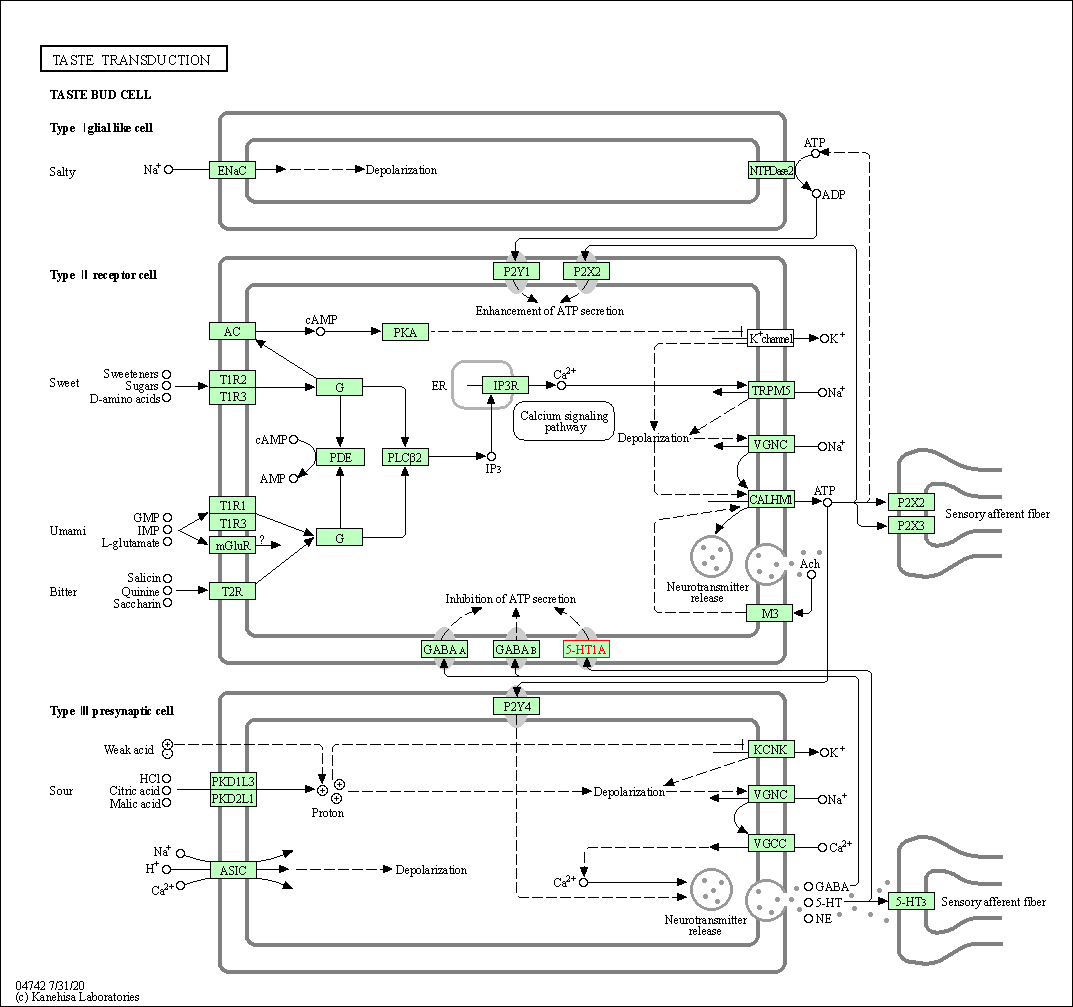Target Information
| Target General Information | Top | |||||
|---|---|---|---|---|---|---|
| Target ID |
T84117
(Former ID: TTDR00564)
|
|||||
| Target Name |
5-HT 1E receptor (HTR1E)
|
|||||
| Synonyms |
Serotonin receptor 1E; S31; 5-hydroxytryptamine receptor 1E; 5-HT1E; 5-HT-1E; 5-HT 1E
Click to Show/Hide
|
|||||
| Gene Name |
HTR1E
|
|||||
| Target Type |
Successful target
|
[1] | ||||
| Disease | [+] 1 Target-related Diseases | + | ||||
| 1 | Pituitary gland disorder [ICD-11: 5A60-5A61] | |||||
| Function |
Functions as a receptor for various alkaloids and psychoactive substances. Ligand binding causes a conformation change that triggers signaling via guanine nucleotide-binding proteins (G proteins) and modulates the activity of down-stream effectors, such as adenylate cyclase. Signaling inhibits adenylate cyclase activity. G-protein coupled receptor for 5-hydroxytryptamine (serotonin).
Click to Show/Hide
|
|||||
| BioChemical Class |
GPCR rhodopsin
|
|||||
| UniProt ID | ||||||
| Sequence |
MNITNCTTEASMAIRPKTITEKMLICMTLVVITTLTTLLNLAVIMAIGTTKKLHQPANYL
ICSLAVTDLLVAVLVMPLSIIYIVMDRWKLGYFLCEVWLSVDMTCCTCSILHLCVIALDR YWAITNAIEYARKRTAKRAALMILTVWTISIFISMPPLFWRSHRRLSPPPSQCTIQHDHV IYTIYSTLGAFYIPLTLILILYYRIYHAAKSLYQKRGSSRHLSNRSTDSQNSFASCKLTQ TFCVSDFSTSDPTTEFEKFHASIRIPPFDNDLDHPGERQQISSTRERKAARILGLILGAF ILSWLPFFIKELIVGLSIYTVSSEVADFLTWLGYVNSLINPLLYTSFNEDFKLAFKKLIR CREHT Click to Show/Hide
|
|||||
| 3D Structure | Click to Show 3D Structure of This Target | AlphaFold | ||||
| Cell-based Target Expression Variations | Top | |||||
|---|---|---|---|---|---|---|
| Cell-based Target Expression Variations | ||||||
| Drug Binding Sites of Target | Top | |||||
|---|---|---|---|---|---|---|
| Ligand Name: BRL54443 | Ligand Info | |||||
| Structure Description | Serotonin 1E (5-HT1E) receptor-Gi protein complex | PDB:7E33 | ||||
| Method | Electron microscopy | Resolution | 2.90 Å | Mutation | Yes | [11] |
| PDB Sequence |
TEKMLICMTL
29 VVITTLTTLL39 NLAVIMAIGT49 TKKLHQPANY59 LICSLAVTDL69 LVAVLVMPLS 79 IIYIVMDRWK89 LGYFLCEVWL99 SVDMTCCTCS109 IWHLCVIALD119 RYWAITNAIE 129 YARKRTAKRA139 ALMILTVWTI149 SIFISMPPLQ172 CTIQHDHVIY182 TIYSTLGAFY 192 IPLTLILILY202 YRIYHAAKSL212 SSTRERKAAR291 ILGLILGAFI301 LSWLPFFIKE 311 LIVGLSIYTV321 SSEVADFLTW331 LGYVNSLINP341 LLYTSFNEDF351 KLAFKKL |
|||||
|
|
||||||
| Click to View More Binding Site Information of This Target with Different Ligands | ||||||
| Different Human System Profiles of Target | Top |
|---|---|
|
Human Similarity Proteins
of target is determined by comparing the sequence similarity of all human proteins with the target based on BLAST. The similarity proteins for a target are defined as the proteins with E-value < 0.005 and outside the protein families of the target.
A target that has fewer human similarity proteins outside its family is commonly regarded to possess a greater capacity to avoid undesired interactions and thus increase the possibility of finding successful drugs
(Brief Bioinform, 21: 649-662, 2020).
Human Pathway Affiliation
of target is determined by the life-essential pathways provided on KEGG database. The target-affiliated pathways were defined based on the following two criteria (a) the pathways of the studied target should be life-essential for both healthy individuals and patients, and (b) the studied target should occupy an upstream position in the pathways and therefore had the ability to regulate biological function.
Targets involved in a fewer pathways have greater likelihood to be successfully developed, while those associated with more human pathways increase the chance of undesirable interferences with other human processes
(Pharmacol Rev, 58: 259-279, 2006).
Human Similarity Proteins
Human Pathway Affiliation
|
|
| KEGG Pathway | Pathway ID | Affiliated Target | Pathway Map |
|---|---|---|---|
| cAMP signaling pathway | hsa04024 | Affiliated Target |

|
| Class: Environmental Information Processing => Signal transduction | Pathway Hierarchy | ||
| Neuroactive ligand-receptor interaction | hsa04080 | Affiliated Target |

|
| Class: Environmental Information Processing => Signaling molecules and interaction | Pathway Hierarchy | ||
| Serotonergic synapse | hsa04726 | Affiliated Target |

|
| Class: Organismal Systems => Nervous system | Pathway Hierarchy | ||
| Taste transduction | hsa04742 | Affiliated Target |

|
| Class: Organismal Systems => Sensory system | Pathway Hierarchy | ||
| Chemical Structure based Activity Landscape of Target | Top |
|---|---|
| Drug Property Profile of Target | Top | |
|---|---|---|
| (1) Molecular Weight (mw) based Drug Clustering | (2) Octanol/Water Partition Coefficient (xlogp) based Drug Clustering | |
|
|
||
| (3) Hydrogen Bond Donor Count (hbonddonor) based Drug Clustering | (4) Hydrogen Bond Acceptor Count (hbondacc) based Drug Clustering | |
|
|
||
| (5) Rotatable Bond Count (rotbonds) based Drug Clustering | (6) Topological Polar Surface Area (polararea) based Drug Clustering | |
|
|
||
| "RO5" indicates the cutoff set by lipinski's rule of five; "D123AB" colored in GREEN denotes the no violation of any cutoff in lipinski's rule of five; "D123AB" colored in PURPLE refers to the violation of only one cutoff in lipinski's rule of five; "D123AB" colored in BLACK represents the violation of more than one cutoffs in lipinski's rule of five | ||
| Co-Targets | Top | |||||
|---|---|---|---|---|---|---|
| Co-Targets | ||||||
| Target Poor or Non Binders | Top | |||||
|---|---|---|---|---|---|---|
| Target Poor or Non Binders | ||||||
| Target Affiliated Biological Pathways | Top | |||||
|---|---|---|---|---|---|---|
| KEGG Pathway | [+] 3 KEGG Pathways | + | ||||
| 1 | cAMP signaling pathway | |||||
| 2 | Neuroactive ligand-receptor interaction | |||||
| 3 | Serotonergic synapse | |||||
| Panther Pathway | [+] 2 Panther Pathways | + | ||||
| 1 | Heterotrimeric G-protein signaling pathway-Gi alpha and Gs alpha mediated pathway | |||||
| 2 | 5HT1 type receptor mediated signaling pathway | |||||
| Reactome | [+] 2 Reactome Pathways | + | ||||
| 1 | Serotonin receptors | |||||
| 2 | G alpha (i) signalling events | |||||
| WikiPathways | [+] 5 WikiPathways | + | ||||
| 1 | Serotonin HTR1 Group and FOS Pathway | |||||
| 2 | Monoamine GPCRs | |||||
| 3 | GPCRs, Class A Rhodopsin-like | |||||
| 4 | GPCR ligand binding | |||||
| 5 | GPCR downstream signaling | |||||
| References | Top | |||||
|---|---|---|---|---|---|---|
| REF 1 | Molecular cloning and pharmacological characterization of the guinea pig 5-HT1E receptor. Eur J Pharmacol. 2004 Jan 26;484(2-3):127-39. | |||||
| REF 2 | Drugs@FDA. U.S. Food and Drug Administration. U.S. Department of Health & Human Services. 2015 | |||||
| REF 3 | Cloning of another human serotonin receptor (5-HT1F): a fifth 5-HT1 receptor subtype coupled to the inhibition of adenylate cyclase. Proc Natl Acad Sci U S A. 1993 Jan 15;90(2):408-12. | |||||
| REF 4 | Toward selective drug development for the human 5-hydroxytryptamine 1E receptor: a comparison of 5-hydroxytryptamine 1E and 1F receptor structure-affinity relationships. J Pharmacol Exp Ther. 2011 Jun;337(3):860-7. | |||||
| REF 5 | The gamma-aminobutyric acid-B receptor agonist baclofen attenuates responding for ethanol in ethanol-dependent rats. Alcohol Clin Exp Res. 2007 Jan;31(1):11-8. | |||||
| REF 6 | SB-216641 and BRL-15572--compounds to pharmacologically discriminate h5-HT1B and h5-HT1D receptors. Naunyn Schmiedebergs Arch Pharmacol. 1997 Sep;356(3):312-20. | |||||
| REF 7 | Characterization of the serotonin receptor mediating contraction in the mouse thoracic aorta and signal pathway coupling. J Pharmacol Exp Ther. 2001 Apr;297(1):88-95. | |||||
| REF 8 | 2-Substituted tryptamines: agents with selectivity for 5-HT(6) serotonin receptors. J Med Chem. 2000 Mar 9;43(5):1011-8. | |||||
| REF 9 | Two amino acid differences in the sixth transmembrane domain are partially responsible for the pharmacological differences between the 5-HT1D beta and 5-HT1E 5-hydroxytryptamine receptors. J Neurochem. 1996 Nov;67(5):2096-103. | |||||
| REF 10 | Molecular cloning of a serotonin receptor from human brain (5HT1E): a fifth 5HT1-like subtype. Proc Natl Acad Sci U S A. 1992 Jun 15;89(12):5517-21. | |||||
| REF 11 | Structural insights into the lipid and ligand regulation of serotonin receptors. Nature. 2021 Apr;592(7854):469-473. | |||||
If You Find Any Error in Data or Bug in Web Service, Please Kindly Report It to Dr. Zhou and Dr. Zhang.

